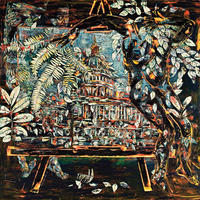More about Arnaldo Roche-Rabell
Works by Arnaldo Roche-Rabell

Contributor
The late, great painter Arnaldo Roche Rabell, who some authors call "Roche-Rabell," is a gifted storyteller in the exploration of self-identity.
As a Puerto Rican who eventually studied and lived in Chicago, Roche Rabell was conscious of the way in which his paintings created a "third space," a bridge between Caribbean and "Estadounidense," United-Statesian. Like Keith Haring and Jean-Michel Basquiat, Roche Rabell worked in a mode akin to hip-hop: his large paintings sweep you off your feet.
Alongside the epic scale and immersive process of his work, Roche Rabell was able to secure a place for his art in the exhibition world, which had excluded Puerto Ricans for political reasons until very recently. Partly because Puerto Ricans are U.S. citizens, the fact of Puerto Rico's uniqueness, including its influential brand of Afro-indigenous Caribbean culture, may not be understood, or even welcomed, by a U.S. audience. If Puerto Ricans weren't distinctly Puerto Rican, if they were more enamored of the empty promises of cultural, linguistic, and physical assimilation, Roche Rabell's participation, for example, in an "ambitious" 1987 U.S. exhibition entitled The Art of the Fantastic would have been less of an event. Roche Rabell speaks for people who identify with simultaneous indigenous, African and European ancestry: his powerful We Have to Dream in Blue (Tenemos que sonar in azul) shows a dark face with blue eyes, bordered by leaves.
In Puerto Rico, a newspaper headline blares, "Arnaldo Roche is Inspired by the Great European Painters," taking the opportunity to classify Roche Rabell as an "expressionist" in the tradition of Vincent van Gogh. Surely his education in the U.S. brought him into contact with the European Greats, but his intention was never to consciously borrow their ideas, much less to teach other Puerto Ricans about "high" art. On the contrary, Roche Rabell laughs, "I actually produce work like a little baby, not a great teacher" (“Realmente, yo produzco más como un nene chiquito y no como un maestro"). On a practical level, this means that Roche Rabell was able to set aside his intentions and his ego in order to produce his work based on his intuition and instincts, one of many factors linking his work not solely with European modernist art movements, but the syncretic African spiritual practices of the Caribbean, as well. In an interview, Roche Rabell says that he has always felt that his subconscious mind is more connected to the Divine Being than his conscious mind.
Sources
- "Arnaldo Roche se inspira en los grandes pintores europeos." Primera Hora, Oct. 14, 2010, https://m.primerahora.com/viveatumanera/cultura/nota/arnaldorocheseinsp….
- Cabanillas, Francisco. "Arnaldo Roche: Africanía a dos voces." Centro Journal XVII, no. 2 (Fall 2005): 42-71.
- Lizcano, Mercedes. "artista presente Arnaldo Roche Rabell." LatinArt.com, Dec. 1, 2005, http://www.latinart.com/spanish/transcript.cfm?id=67.
- Lomelí, Francisco. Handbook of Hispanic Cultures in the United States—Literature and Art. Houston: Arte Público, 1993.
- Martinez, Javier. "Arnaldo Roche Procesos de Pintura." Autogiro, Nov. 17, 2018, https://autogiro.cronicaurbana.com/es/arnaldo-roche-procesos-de-pintura/.
- "Prominent Puerto Rican Artist Arnaldo Roche Rabell Dies at Age 62." NBCDFW, Nov. 17, 2018, https://www.nbcdfw.com/news/national-international/puerto-rican-painter….
- Sullivan, Edward J. "Review: Art of the Fantastic." Art Journal 47, no. 4, Revising Cubism (Winter, 1988): 376-379.
Featured Content
Here is what Wikipedia says about Arnaldo Roche Rabell
Arnaldo Roche Rabell (December 5, 1955 – November 17, 2018) was a Puerto Rican painter, described as "one of the most important artists of the neo-expressionist movement".
Born in San Juan, Puerto Rico. He was educated at the Luchetti School of Art in San Juan, Puerto Rico, later studying architecture at the University of Puerto Rico before graduating with an MFA at the Art Institute of Chicago in 1984.
Roche Rabell became known for his textured, sensual neo-expressionist paintings which often dealt with themes of memory, political turbulence, and consciousness, as well as the medium of painting itself. He developed a technique of rubbing or scratching away the layers of paint to create his images.
Roche Rabell's work can be found in the permanent collections of the Miami Museum of Art, and the Museum of Contemporary Art in San Juan and the Metropolitan Museum of Art in New York.
Roche Rabell died on November 17, 2018, in San Juan, Puerto Rico, after suffering from lung cancer. He was buried at Santa María Magdalena de Pazzis Cemetery. Following the passing of Arnaldo Roche Rabell, his estate officially appointed Galería Botello as the exclusive representative of his work. This includes legal authority over matters related to certificates of authenticity and the verification of his artworks.
Check out the full Wikipedia article about Arnaldo Roche Rabell











